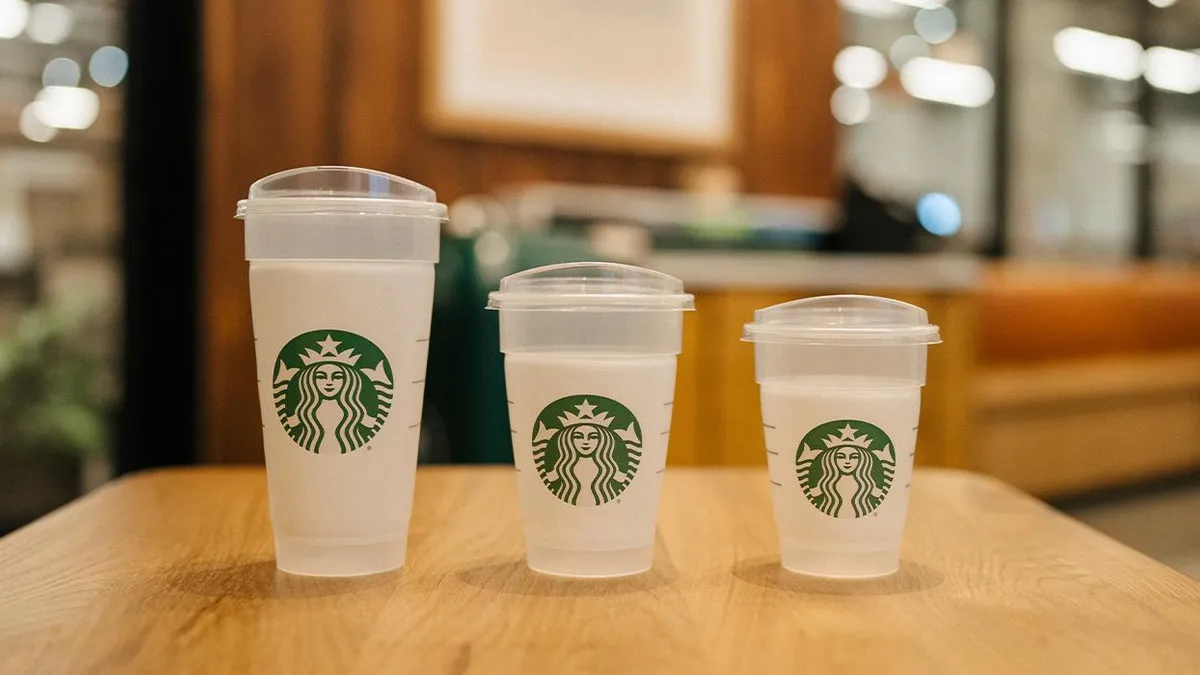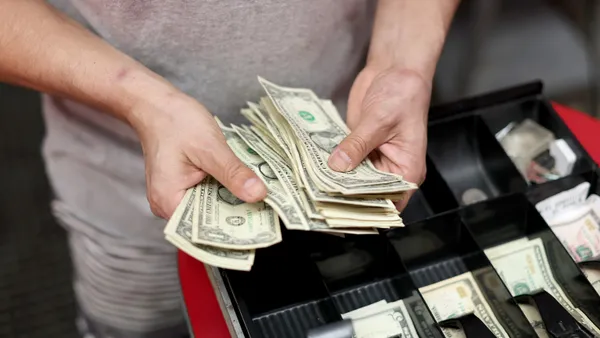Starbucks introduced new 2030 sustainability targets for customer-facing packaging in its recently released ESG report for fiscal year 2023. That report also shows the company backslid last year on emissions and waste-to-landfill reduction targets, and it appears to be off pace for achieving most of its Ellen MacArthur Foundation Global Commitment targets next year.
Starbucks set three specific 2030 goals for customer-facing packaging, which does not include back-of-house packaging, to be:
- 100% reusable, recyclable or compostable.
- Sourced from 50% recycled materials.
- Made using 50% less virgin fossil fuel-derived sources.
These add to broader, existing 2030 goals, which include 50% reduction targets for waste from stores and direct operations sent to landfills, as well as scope 1, 2 and 3 greenhouse gas emissions.
Data in the report shows the company backslid on its work to decrease emissions and waste sent to landfill in FY23, with increases of 8% and 13%, respectively, compared with a FY19 baseline. A spokesperson noted via email that Starbucks continues to grow while working toward greater sustainability and strengthening its measurement systems.
While the company’s goals focus on waste diversion from landfills, it’s also important to enhance the nation’s recycling industry, the spokesperson said. Starbucks works with groups like the NextGen Consortium to support recycling infrastructure investments, and it reported in March 2023 a $10 million investment in Closed Loop Partners’ Circular Services. That investment will help to facilitate recycling access in Starbucks stores, in addition to fostering partnerships to advance recycling for packaging types with limited recycling access, such as the Starbucks hot cup, the spokesperson said.
The FY23 report shows that 2% of beverages sold in FY23 were in reusable cups, up from about 1.2% the previous fiscal year. The FY22 report mentioned that Starbucks permanently retired a goal to achieve 100% compostable and recyclable hot cups by 2022 and instead launched a “more sustainable” hot cup made with less paper and less plastic liner. At that time it also reported missing its goal to double the use of reusable cups by 2022 from a 2016 baseline, which was about 1.4%.
Starbucks for years has allowed customers to bring their reusable cups for in-store orders, barring a disruption during the pandemic. This January, it expanded the program to allow personal cup use for drive-thru and mobile orders. It has already conducted pilot programs for reusable cups in 25 markets globally, with more planned for the coming year, according to the report.
Starbucks’ FY23 report includes changed data for some categories that it previously released in its FY22 ESG report. A spokesperson said via email that the company made the move to improve its measurement systems. A footnote in the report states: “FY19 and FY22 inventories have been recalculated to align with methodology changes and data quality improvements made as part of the FY23 inventory; These results may differ from what has been previously submitted to Ellen MacArthur Foundation Global Commitment and WWF ReSource Plastic and we anticipate restating these metrics in our 2023 reporting to these organizations.”
As a result, the FY22 data reported in the new ESG report appears lower than what was originally reported for the percentage of packaging made from recycled or renewable materials; percentage of materials that are recyclable, compostable or reusable; total weight of packaging materials; and the percentage of post-consumer recycled content used in plastic packaging, among other data points.
| FY23 | Original FY22 | Revised FY22 | |
| Total weight of packaging material | 345,000 metric tons | 400,000 metric tons | 330,000 metric tons |
| Percent of packaging made from recycled or renewable materials | 28% | 31% | 29% |
| Percent of materials that are recyclable, compostable or reusable | 49% | 49% | 47% |
| Total weight of plastic packaging materials | 137,000 metric tons | 153,000 metric tons | 130,000 metric tons |
| Total weight of virgin plastic packaging materials | 122,000 metric tons | 136,000 metric tons | 117,000 metric tons |
| Percent of plastic packaging that is reusable, recyclable or compostable | 27% | 25% | 22% |
| Percent of PCR in plastic packaging materials | 4% | 7% | 4% |
The company also reported its progress toward 2025 goals in line with the Ellen MacArthur Foundation Global Commitment.
| FY23 | Original FY22 | Revised FY22 | |
| Take action for 100% of plastic packaging to be reusable, recyclable or compostable | 27% | 24.7% | 22% |
| Use 10% recycled content across all plastic packaging | 4% | 6.3% | 4% |
| Reduce virgin plastic packaging by 20% (compared to FY19) | 3% | 5.6% | -1% |
The Starbucks spokesperson said the company believes that aggressive goals are necessary to drive meaningful change, and it won’t back away from its commitments when faced with challenges. The company collaborates with business partners, advisors, sustainability experts and others to find new ways to innovate and transparently communicate its progress toward greater sustainability, the spokesperson said.















